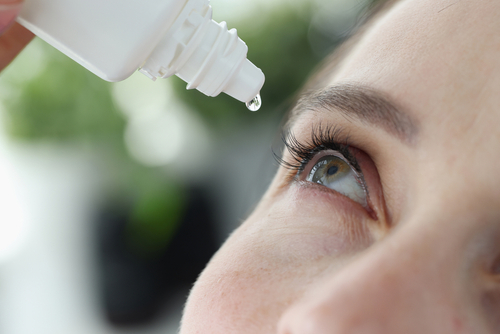Is It Dry Eye or Allergies?
October 11, 2023
 October can be one of the worst months for allergies in Maryland! As fall sets in, exposure to ragweed pollen and other common allergens can cause symptoms that affect the eyes of many allergy sufferers, including redness, stickiness, itching, and irritation.
October can be one of the worst months for allergies in Maryland! As fall sets in, exposure to ragweed pollen and other common allergens can cause symptoms that affect the eyes of many allergy sufferers, including redness, stickiness, itching, and irritation.
However, seasonal allergies are not the only condition that can cause these eye-related symptoms. Dry eye syndrome, a common eye condition, can also present similar symptoms to allergies, making it easy to confuse one condition with the other.
There are some critical differences between dry eye syndrome and allergies, which are important to know in order to provide the most effective treatment for your uncomfortable eyes. Keep reading to learn more about dry eye and allergies!
What is Dry Eye Syndrome?
Dry eye syndrome is an eye condition that primarily occurs when your eyes do not produce enough tears, or the tears your eye does produce are of poor quality. Your eyes need a certain amount of tear production to keep them properly lubricated, maintain clear vision, and prevent eye discomfort.
What Are the Symptoms of Dry Eye Syndrome?
The most common symptoms of dry eye syndrome are:
- Eyes that sting, burn, or feel scratchy
- Pronounced eye redness
- Blurred, impaired, or fluctuating vision
- Excessively watery eyes
- Eye fatigue when looking at a computer screen or reading
- A heightened sensitivity to environmental factors, like wind or smoke
What Causes Dry Eye Syndrome?

There are a number of potential causes of dry eye syndrome, but the most common cause is aging. As you age, the tears your eyes produce contain less of the naturally occurring lubricating oils that keep your eyes moist.
Other causes include:
- Looking at electronic screens for extended periods
- Living in windy or desert-like climates
- Certain underlying medical conditions, including rheumatoid arthritis and thyroid disorders
- Hormonal changes
How is Dry Eye Syndrome Treated?
Treatment of dry eye syndrome depends on the underlying cause of the condition. For dry eye syndrome caused by extended screen time or environmental factors it can be successfully treated using over-the-counter or prescription eyedrops as well as self-help behaviors, like taking regular breaks to rest your eyes while using a computer or other electronic device and regularly using a humidifier in your home.
If a person’s dry eye syndrome is caused by physiological changes that do not respond to medication, there are surgical procedures that can relieve symptoms. The most common is punctal plug insertion, which aims to reduce tear drainage and increase the amount of tears continually present within the eye.
What are Allergies?
Allergies are the immune system’s response to contact with an allergen, including pollen, dust mites, pet dander, insect bites, and certain foods. When the body comes into contact with an allergen, the immune system releases histamines, which are chemicals that tell the body to “defend” itself against the allergen.
What are the Symptoms of Allergies?
The most common symptoms of allergies are:
- Red or itchy eyes
- Excessively watery eyes
- Sneezing
- A runny or stuffy nose
- Rashes or hives
- Headaches and fatigue
What Causes Allergies?
Allergies are caused by exposure to allergens, like taking an outdoor walk during pollen season, visiting a home with pets, or eating certain foods. Not all people with allergies are sensitive to the same allergens.
For instance, a person could be allergic to peanuts but not affected by ragweed pollen and vice versa. Allergies can develop at any point during a person’s life, but the risk of developing certain allergies can be genetic. Some allergies resolve themselves on their own, while others are present throughout a person’s life.
How are Allergies Treated?
 Allergies are usually treated with over-the-counter or prescription medications. These medications include antihistamines, which prevent the release of histamines, and decongestants, which can alleviate allergy symptoms.
Allergies are usually treated with over-the-counter or prescription medications. These medications include antihistamines, which prevent the release of histamines, and decongestants, which can alleviate allergy symptoms.
For more severe allergies, an allergy specialist may recommend immunotherapy, which aims to reduce allergy symptoms by exposing the body to small amounts of allergens over a long period of time. Certain allergies, like an allergy to bee stings, require people to carry a supply of the drug epinephrine, which can control an allergic reaction until emergency help arrives.
While dry eye syndrome and allergies can easily be confused as they can present very similar symptoms, it is important to have both accurately diagnosed. Untreated dry eye syndrome can cause damage to the eye that can result in vision loss, while an undiagnosed allergy can be potentially life-threatening.
To protect the health of your eyes and your overall health, it is important that you consult your medical care professional if you are experiencing the signs and symptoms of dry eye syndrome or allergies! While your physician can help determine if allergies have you constantly wiping your nose and sneezing through October, your eye doctor can perform a comprehensive eye exam to determine whether dry eye syndrome is the cause of your red and itchy eyes!
Are you experiencing symptoms of dry eye syndrome or allergies? Schedule an appointment at Advanced Eye Care in Bel Air, MD, today!



